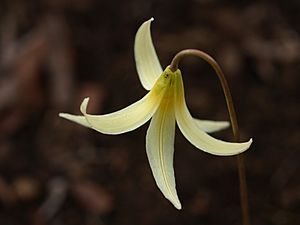Giant white fawnlily facts for kids
Quick facts for kids Giant white fawnlily |
|
|---|---|
 |
|
| Conservation status | |
| Scientific classification | |
| Genus: |
Erythronium
|
| Species: |
oregonum
|
| Synonyms | |
|
Synonymy
Erythronium revolutum var. albiflorum Purdie
Erythronium revolutum var. praecox Purdy Erythronium revolutum var. watsonii Purdy Erythronium giganteum subsp. leucandrum Applegate Erythronium oregonum subsp. leucandrum (Applegate) Applegate |
|
Erythronium oregonum, also called the giant white fawnlily or Oregon fawn-lily, is a beautiful flowering plant. It belongs to the lily family. This plant grows naturally in western North America. You can find it in the Pacific Coast Ranges, from southwestern British Columbia down to northern California.
Contents
Where the Fawnlily Grows
The giant white fawnlily is found in North America. It grows from southern British Columbia all the way south to northern California. It prefers areas west of the Cascade Range, reaching into the Coast Range and Siskiyous. You can often spot it in open meadows and mixed woodlands at lower elevations.
What the Fawnlily Looks Like
Erythronium oregonum is a type of wildflower. It grows from a bulb that is about 3 to 5 centimeters wide. The plant has long, lance-shaped green leaves. These leaves can grow up to 22 centimeters long. They often have cool brown and white patterns, like spots.
Thin, bare stalks grow up to about 40 centimeters tall. Each stalk usually has one flower, but sometimes it can have more.
Flower Details
Each flower has white tepals, which are like petals and sepals combined. The bases of these tepals are yellow. Sometimes, you might see faint red streaks on them. The flower often hangs down, facing the ground. Its tepals curve backward, so their tips point upwards.
The stamens and stigma inside the flower are white. The anthers, which hold pollen, can be white or yellow. Beetles and flies help pollinate these flowers. This means they help the plant make seeds.
How Animals and People Use It
Bears are known to eat the entire giant white fawnlily plant.
Native Americans also used this plant. They would eat the roots, either raw or cooked.
The Fawnlily's Name
The name "fawn lily" is quite interesting. It is said that John Burroughs gave it this name. He thought the two leaves of the plant looked like the perked-up ears of a young deer, called a fawn. Another idea is that the name "fawn" refers to the mottled, spotted coloring of the leaves. This pattern looks a bit like a fawn's spotted coat.
See also
 In Spanish: Erythronium oregonum para niños
In Spanish: Erythronium oregonum para niños



